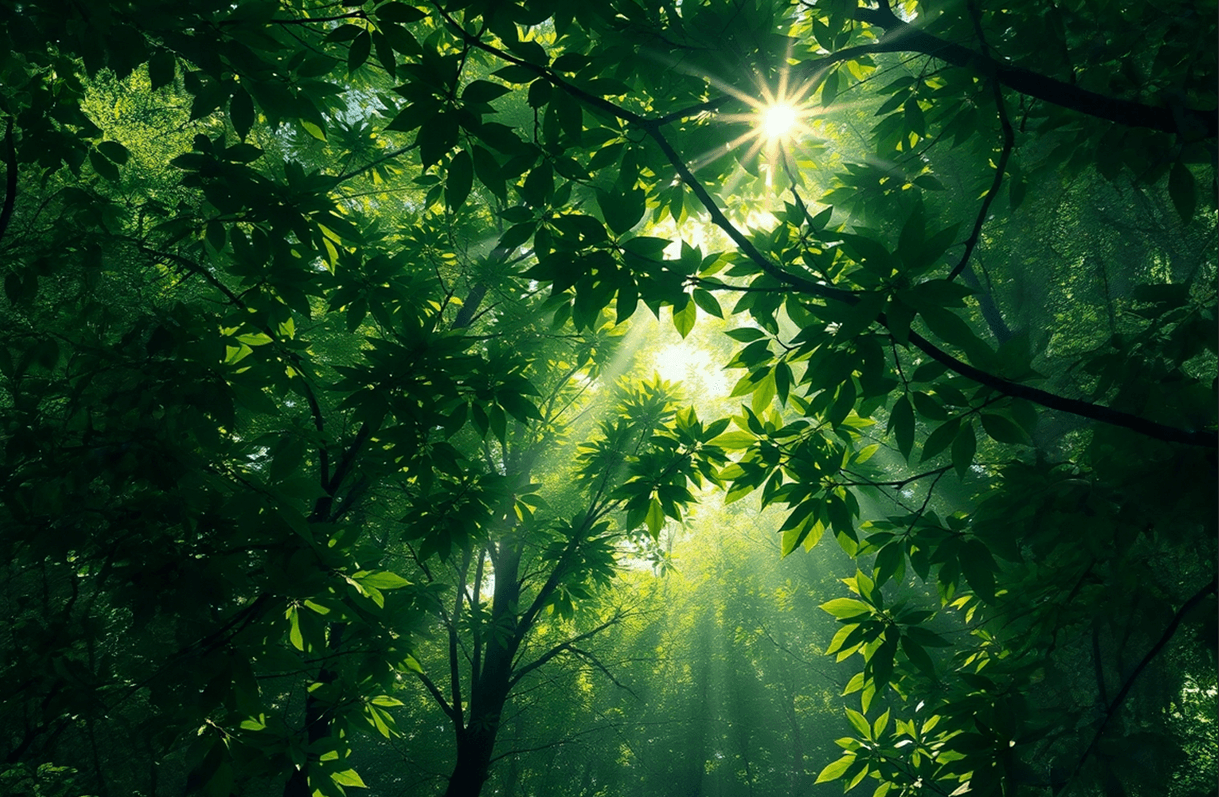Why Are Plants Green? How Light Absorption Shapes Their Color
Hind MoutaoikiIR&D Manager
Wed Jul 02 2025

There's a moment in childhood when we first truly notice the overwhelming greenness of the world around us. Perhaps it's lying on summer grass, gazing up at the canopy of leaves that filters sunlight into dancing patterns of emerald and gold. Or maybe it's the sudden realisation that amongst all of nature's palette—the azure sky, the brown earth, the silver streams—green dominates with such quiet authority that we've almost stopped seeing it.
Why green? This question, so simple a child might ask it, touches upon one of the most profound stories in the history of life on Earth. It's a tale of cosmic accident and evolutionary genius, of molecules that learned to harvest starlight and transform it into the very essence of life. To understand why plants are green is to glimpse the elegant machinery that powers our world, and to appreciate how the colour of chlorophyll shapes not just gardens, but entire ecosystems, atmospheres, and the possibility of complex life itself.
The Dance of Light and Matter
To understand the greenness of plants, we must first appreciate light itself—that strange phenomenon that behaves sometimes like a wave, sometimes like a particle, always like pure energy cascading through space. Sunlight, which appears white to our eyes, is actually a symphony of colours, each with its own energy signature. When Isaac Newton first split sunlight through a prism, revealing the hidden rainbow within, he unknowingly provided the key to understanding why our world is painted in chlorophyll's particular shade.
Light carries energy in discrete packets called photons, and different colours carry different amounts of this energy. Violet and blue photons are energetic little packets, whilst red photons are more leisurely in their energy content. Plants, in their ancient wisdom, have learned to capture and use this light energy through a process so fundamental that life as we know it depends upon it entirely.
But here's where the story becomes wonderfully counterintuitive: plants appear green not because they use green light, but because they don't. The colour we see is the colour they reject, the light they cannot or will not absorb. It's rather like understanding a person by what they choose not to say—sometimes the absence reveals more than the presence.
Chlorophyll: The Master of Light
At the heart of every green leaf lies chlorophyll, perhaps the most important molecule in the history of our planet. This remarkable compound, with its magnesium centre surrounded by a ring of carbon and nitrogen atoms, is evolution's answer to the challenge of capturing light energy and transforming it into chemical energy. It's a molecular solar panel, refined over billions of years to perform one of nature's most essential tasks.
Chlorophyll comes in several varieties, but the two most important are chlorophyll-a and chlorophyll-b. These molecules are exquisitely tuned to absorb light at specific wavelengths. Chlorophyll-a drinks deeply from the red end of the spectrum (around 665-675 nanometres) and the blue-violet end (around 430-445 nanometres). Chlorophyll-b complements this by absorbing slightly different wavelengths, particularly in the blue (around 455 nanometres) and red (around 640 nanometres) regions.
What they both do poorly is absorb green light, which sits in the middle of the visible spectrum at around 500-600 nanometres. This green light bounces off the leaf's surface and travels to our eyes, giving plants their characteristic colour. It's a beautiful irony: the colour that defines plant life is precisely the colour that plants find least useful.
The Architecture of Absorption

The story of plant colour extends far beyond chlorophyll alone. Within each leaf lies a complex architecture designed to optimise light capture and utilisation. The uppermost layer, the epidermis, is often transparent or lightly pigmented to allow light to penetrate. Beneath this lies the palisade mesophyll, packed with chloroplasts—the cellular powerhouses where photosynthesis occurs.
Each chloroplast contains not only chlorophyll but also a suite of accessory pigments that fine-tune the plant's relationship with light. Carotenoids, those molecules responsible for the orange of carrots and the yellow of autumn leaves, help capture light that chlorophyll cannot absorb and transfer that energy to the photosynthetic machinery. They also serve as protective agents, absorbing excess light energy that might otherwise damage the delicate photosynthetic apparatus.
These accessory pigments reveal why plant colour is more nuanced than simple green. The particular shade of a leaf—whether it's the deep forest green of a rhododendron or the pale lime of new spring growth—depends on the precise mixture of chlorophyll and accessory pigments within its cells. It's a biochemical palette that would make any artist envious.
Beyond Green: The Spectrum of Plant Life
Not all plants are green, of course, and these exceptions illuminate the rules that govern plant coloration. Red seaweeds, for instance, have evolved to thrive in deep ocean waters where red light cannot penetrate. Their red pigment, phycoerythrin, allows them to capture the blue-green light that does reach the ocean depths and transfer that energy to their photosynthetic machinery.
Purple bacteria, some of Earth's earliest photosynthetic organisms, use a completely different system based on bacteriorhodopsin, which absorbs green light efficiently. This suggests that the green gap of higher plants isn't an inevitable consequence of photosynthesis but rather one evolutionary solution among many possible approaches to light harvesting.
Even among terrestrial plants, we find fascinating variations. The deep red leaves of some cultivars, the silvery foliage of certain desert plants, the almost black leaves of some tropical understory species—each represents a different strategy for managing the relationship between light absorption and plant survival.
The Changing Seasons of Colour
Perhaps nowhere is the relationship between light and plant colour more dramatically displayed than in the changing seasons. The spectacular autumn transformation that sets forests ablaze with gold, orange, and scarlet tells a story of chlorophyll breakdown and pigment revelation.

As daylight hours shorten and temperatures drop, many plants begin to withdraw resources from their leaves in preparation for winter dormancy. Chlorophyll, being energetically expensive to maintain, is broken down and its components recycled. As the green pigment disappears, the carotenoids that were always present but masked by chlorophyll's dominance are finally revealed in all their golden glory.
The brilliant reds of autumn are often newly manufactured anthocyanins—pigments that may serve to protect the remaining photosynthetic apparatus from light damage during this vulnerable transition period. It's as if plants are painting themselves one last time before winter's sleep, creating beauty as a byproduct of biochemical necessity.
A World Painted by Physics
In the end, the question of why plants are green reveals something profound about the relationship between physics and biology, between the fundamental properties of matter and energy and the emergence of life and beauty. The green of chlorophyll isn't arbitrary—it's the result of quantum mechanical properties of molecules, the wavelengths of stellar light, and the evolutionary pressures that have shaped life over billions of years.
Every time we ask why the world is the way it is, we're engaging in the same fundamental curiosity that drives scientific discovery. The child lying on summer grass, wondering why it's green, is participating in the same tradition of inquiry that has revealed the structure of DNA, the age of the universe, and the mechanism of photosynthesis itself.
And perhaps that's the most beautiful aspect of this story: that the simple act of noticing colour—something so basic that we often take it for granted—can lead us to some of the deepest truths about life, evolution, and our place in the cosmos. The green of plants connects us to the physics of light, the chemistry of molecules, the history of evolution, and the future possibilities of technology and sustainability.
The green of plants is more than a colour—it's a signature of the cosmic conversation between matter and energy, between starlight and life, between the physics of the universe and the biology of our world. And in that conversation, we find not just understanding, but wonder.
previous
The Psychology of Listening: How to Deepen Our Listening
next
Elder Voices of the Millennium: Theodore Zeldin
Share this
Hind MoutaoikiI
R&D Manager
Hind is a Data Scientist and Computer Science graduate with a passion for research, development, and interdisciplinary exploration. She publishes on diverse subjects including philosophy, fine arts, mental health, and emerging technologies. Her work bridges data-driven insights with humanistic inquiry, illuminating the evolving relationships between art, culture, science, and innovation.
More Articles

The Unique Mural Art of Morocco: Exploring the Stories and Symbols Behind the Walls
The Great Barrier Reef: Exploring the Future of Australia's Iconic Marine Ecosystem

Exploring the Future of Transportation: Innovations Shaping Mobility in 2025 and Beyond

Unveiling The Spiritual Significance of the Hawk: Messages from Above

Exploring the Invisible World of Emotions: Understanding Your Inner Landscape





